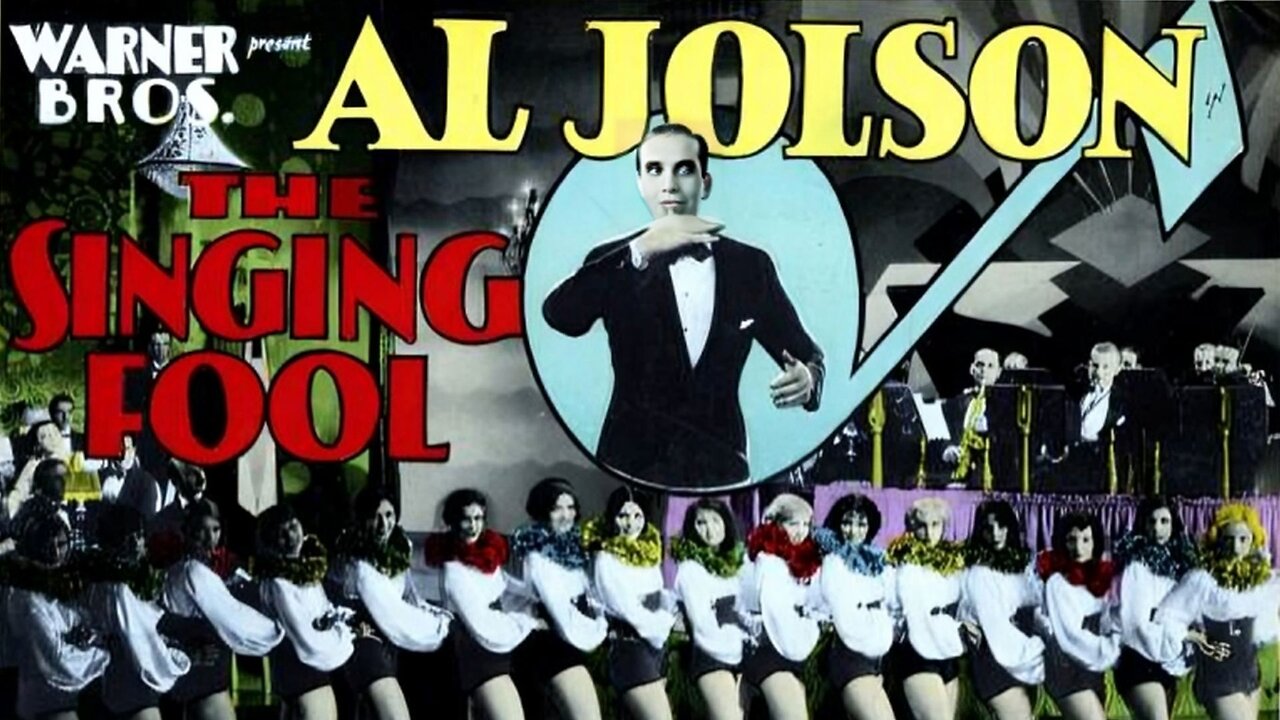Premium Only Content

THE SINGING FOOL (1928) Al Jolson, Betty Bronson & Josephine Dunn | Drama, Musical | B&W
The Singing Fool is a 1928 American sound part-talkie musical drama motion picture directed by Lloyd Bacon which was released by Warner Bros. In addition to sequences with audible dialogue or talking sequences, the film features a synchronized musical score and sound effects along with English intertitles. The soundtrack was recorded using the Vitaphone sound-on-disc system. The film stars Al Jolson and is a follow-up to his previous film, The Jazz Singer. It is credited with helping to cement the popularity of American films of both sound and the musical genre. The film entered the public domain on January 1, 2024.
SYNOPSIS
A singing waiter and composer (Al Jolson) loves two women (Betty Bronson, Josephine Dunn), conquers Broadway and holds his dying son, singing "Sonny Boy."
After years of hopeful struggle, Al Stone (Jolson) is on his way to stardom. He plays a blackface minstrel.
"I'm Sittin' on Top of the World", he sings to an appreciative speakeasy crowd. But, as Al discovers, getting there is one thing. Staying there is another. Singing waiter Stone gets his huge break on a magical night when his song wows a big-time producer and a gold-digging showgirl he fancies. Broadway success and marriage follow, but sure enough, hard times are on the way. Al's fickle wife abandons him, taking the beloved son he calls Sonny Boy with her. Heartbroken, Al becomes a devastated loner until friends from the speakeasy that launched his career rescue him from a life on the streets.
CAST & CREW
Al Jolson as Al Stone
Betty Bronson as Grace
Josephine Dunn as Molly Winton
Arthur Housman as Blackie Joe
Reed Howes as John Perry
Davey Lee as Sonny Boy
Edward Martindel as Louis Marcus
Robert O'Connor as Bill, cafe owner
Helen Lynch as Maid
Agnes Franey as "Balloon" girl
The Yacht Club Boys as Singing quartet
Directed by Lloyd Bacon
Written by C. Graham Baker (scenario), Joseph Jackson (dialogue & titles)
Based on "The Singing Fool" (short story) by Leslie Burrows
Cinematography Byron Haskin
Edited by Ralph Dawson
Production company Warner Bros. Pictures
Distributed by Warner Bros. Pictures
Release dates September 19, 1928 (New York City), September 29, 1928 (United States)
Running time 102 minutes
Country United States
Languages English Sound (Part-Talkie)
English Intertitles
Budget $388,000
Box office $5,916,000
NOTES
Like The Jazz Singer, The Singing Fool was a melodrama with musical interludes, and as such was one of the film industry's first musical films. Produced during the transition period between silent film and talkies, the movie was released in both sound and silent versions.
The Singing Fool was a part-talking feature, which featured a synchronized musical score with sound effects along with synchronized musical and talking sequences, although in this film roughly 66 minutes of talking and singing were included. Al Jolson's first all-talking feature, Say It With Songs, would appear in 1929.
The Singing Fool solidified Jolson's position atop the movie world; not until Snow White and the Seven Dwarfs would any sound-era film be more financially successful than this audience-pleasing blend of sentiment and show biz. With a worldwide gross of $5.9 million,[5] it would remain the most successful film in Warner Bros. history until the release of Sergeant York in 1941.
According to Warner Bros records the film earned $3,821,000 domestically and $2,095,000 foreign.
For the majority of movie audiences, The Singing Fool became their first experience with a talking film, since few movie theaters had been equipped with a sound system in 1927. The film's positive reception was also viewed as a signifier that sound films were here to stay. "Here is complete vindication for the advocates of sound pictures", wrote Film Daily. "The Singing Fool is the finest example of sound pictures made to date." Mordaunt Hall of The New York Times wrote that the dialogue was "a little halting" and that Dunn was "not convincing", but recognized that the main point of interest in the film was "not in its transparent narrative, but in Mr. Jolson's inimitable singing", and on that basis it was "capital entertainment." John Mosher of The New Yorker also recommended the film, writing, "Fortunately, throughout this picture one has Al Jolson's own songs to listen to, for the story has been contrived to exploit to the full his special talents. Whenever the action begins to slump and lag, Al has only to step forward and do his stuff, and the day is saved." One trade paper commentator stated that The Singing Fool "will be to talking pictures what The Birth of a Nation has been to silent pictures".
For a time, the film also made Davey Lee, Jolson's 31⁄2 year old co-star, the most popular child star since Jackie Coogan. Lee was re-teamed with Jolson in Say It With Songs and starred in a few other films—including 1929's Sonny Boy—until his parents pulled him out of the movie business.
-
 11:17
11:17
Lost n Found Films
20 hours agoTHE WHITE OUTLAW (1929) Podcast | Free Movie
44 -
 LIVE
LIVE
Eternal_Spartan
5 hours agoLive at 11am Central!! | Clari Obscur Expedition 33 - Possibly the Best Game of My Life?!?
151 watching -
 13:05
13:05
Cowboy Kent Rollins
1 day ago $11.14 earnedHomemade Cowboy Corn Dogs | Easy Corndog Recipe
39.5K23 -
 LIVE
LIVE
GritsGG
4 hours ago#1 Warzone Win Grind! 🔥
108 watching -
 8:24
8:24
Talk Nerdy Sports - The Ultimate Sports Betting Podcast
4 hours ago4/26/25 - Saturday Annihilation: Vasil’s 8 Sharp Picks and 2 PrizePicks Built for Blood 💥📈
42.9K1 -
 LIVE
LIVE
GamingWithHemp
4 hours agoElder Scrolls Oblivion Remastered Episode #2 Ultra high settings
125 watching -
 2:11:49
2:11:49
Rotella Games
22 hours agoSaturday Morning Family Friendly Fortnite
30.7K6 -
 2:13:45
2:13:45
I_Came_With_Fire_Podcast
13 hours agoRESTRUCTURING THE WORLD- CIVICS CLASS WITH DAN HOLLAWAY
33.9K17 -
 DVR
DVR
Bannons War Room
2 months agoWarRoom Live
14.2M3.58K -
 LIVE
LIVE
Total Horse Channel
1 day agoYELLOWSTONE SLIDE I | SATURDAY
156 watching